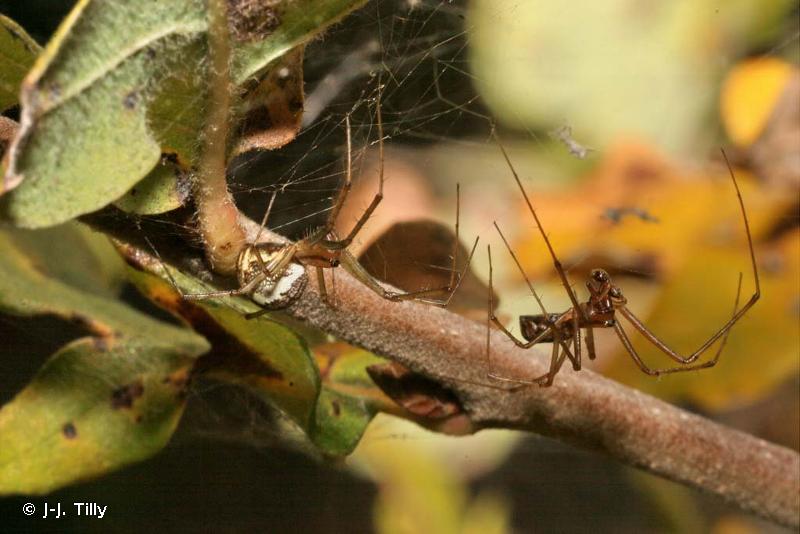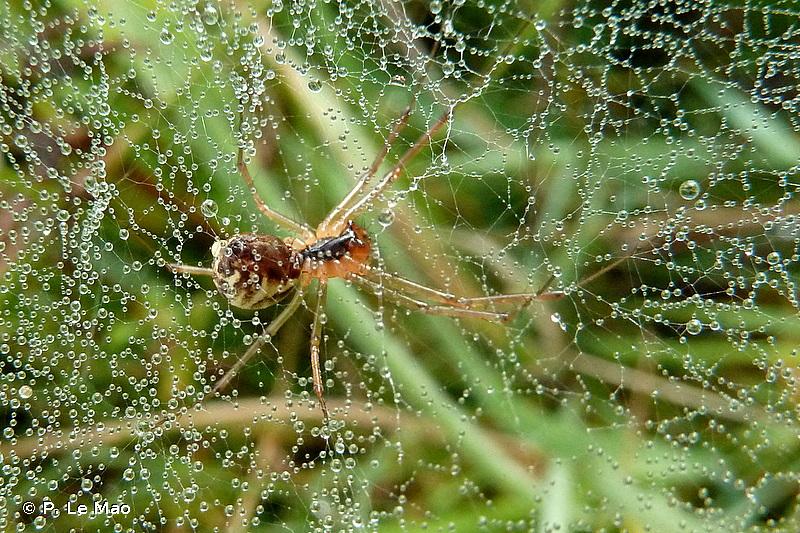
cd_nom

| Author : J-J. Tilly |
 |
To get the picture, please visit:
Jean-Jacques Tilly
Association française d'Arachnologie
http://asfra.fr/Site/Main_public.html
email : inpn@mnhn.fr
Any reuse of one or more photographs on this site is subject to an authorization request from the author.
Link to the Code of Intellectual Property (Legifrance)

| Author : P. Le Mao |
 |
To get the picture, please visit:
Patrick Le Mao
Association française d'Arachnologie
http://asfra.fr/Site/Main_public.html
email : inpn@mnhn.fr
Any reuse of one or more photographs on this site is subject to an authorization request from the author.
Link to the Code of Intellectual Property (Legifrance)

| Author : S. Lecigne |
 |
To get the picture, please visit:
Sylvain Lecigne
inpn@mnhn.fr
Despite the Creative Commons license, please inform the author of the use which will be made of his photo
Distribution mondiale
toute l'Europe, Afrique du Nord, Asie du Nord
Caractères distinctifs, espèces
Taille - femelle : 6 mm, mâle : 5-7 mm.
La coloration du céphalothorax est caractéristique de cette espèce ainsi que d'une autre proche (L. tenuitarsis) avec, sur fond clair, une bande sombre digitée à l'avant. Le dessin du dos de l'abdomen est lui aussi assez caractéristique. Dans les genres Linyphia, Neriene, Frontinellina et Microlinyphia, autrefois réunis, les dessins du dos de l'abdomen permettent souvent l'identification des espèces, au moins des femelles. Il y a une quinzaine d'espèces dans ces genres en France.
Milieux colonisés
L'espèce colonise des milieux buissonneux très variés et tisse sa toile .
Chasse
L'araignée tisse une toile bien horizontale, en nappe non collante, supportée par de nombreux fils accrochés à la végétation. Elle a l'aspect d'un chapiteau de cirque surélevé en plusieurs points comme par des mats. L'araignée se déplace suspendue sous la nappe et capture des proies volantes ou qui sautent dans la nappe.
Développement, cycle
Les mâles sont présents de juillet à septembre, les femelles de juillet à novembre. Le cycle est annuel.
Le mâle devient adulte avant la femelle et gagne la toile d'une immature. Il restera avec elle, y compris après sa mue de maturité, pendant une longue période, se nourrissant dans la toile. Dans la toile de la femelle, le mâle se ménage une toile spermatique pour remplir ses bulbes copulateurs. Il féconde périodiquement la femelle, capture des proies et éventuellement chasse d'autres mâles qui essayent de s'introduire sur la toile. La femelle pond de trente à cinquante œufs dans un cocon en forme de poire. La femelle le dépose près du sol, dans la litière. On voit parfois, mais rarement, deux cocons ensemble. Les œufs passent l'hiver et les jeunes n'en sortent qu'au printemps.
A. Canard(Université de Rennes/Service du Patrimoine Naturel, MNHN),2014
Continental
Metropolitan France
Overseas
Marine
Metropolitan France
Overseas
The map presents a summary at the 10 x 10 km grid of the observation data for the species transmitted to the SINP. These data have been subjected to validation filters.
The map presents a reference distribution layer of the species at the scale of departments and marine sectors. The presence and absence data were established by expertise within a network of partners. This reference distribution is used in the validation process of the SINP data at the INPN level.
Corresponds to a report on the basis of at least one observation proved within a period of 10 years (20 years for little-known invertebrates) preceding the year and no presumption of extinction since obtaining the last data nor doubt on reproductive and implemented nature of this population. For migratory species, the presence indicated concerns areas of reproduction.
This status is based on one or more of the following criteria:
This point covers the absence, more difficult by nature to demonstrate than presence. This status is based on one or more of the following criteria:
This status must be assigned to a department in which the presence of the species is casual.
Particular case of absence due to a proven extinction less than a half century ago (older disappearances are treated as "no probable or definite").
In the state of knowledge, we can not comment on the presence or absence in the current department. This is the default status when not comprised in one of the previous categories or whenever there is doubt.
The map shows the global distribution of the species based on GBIF data (Global Biodiversity Information Facility).
